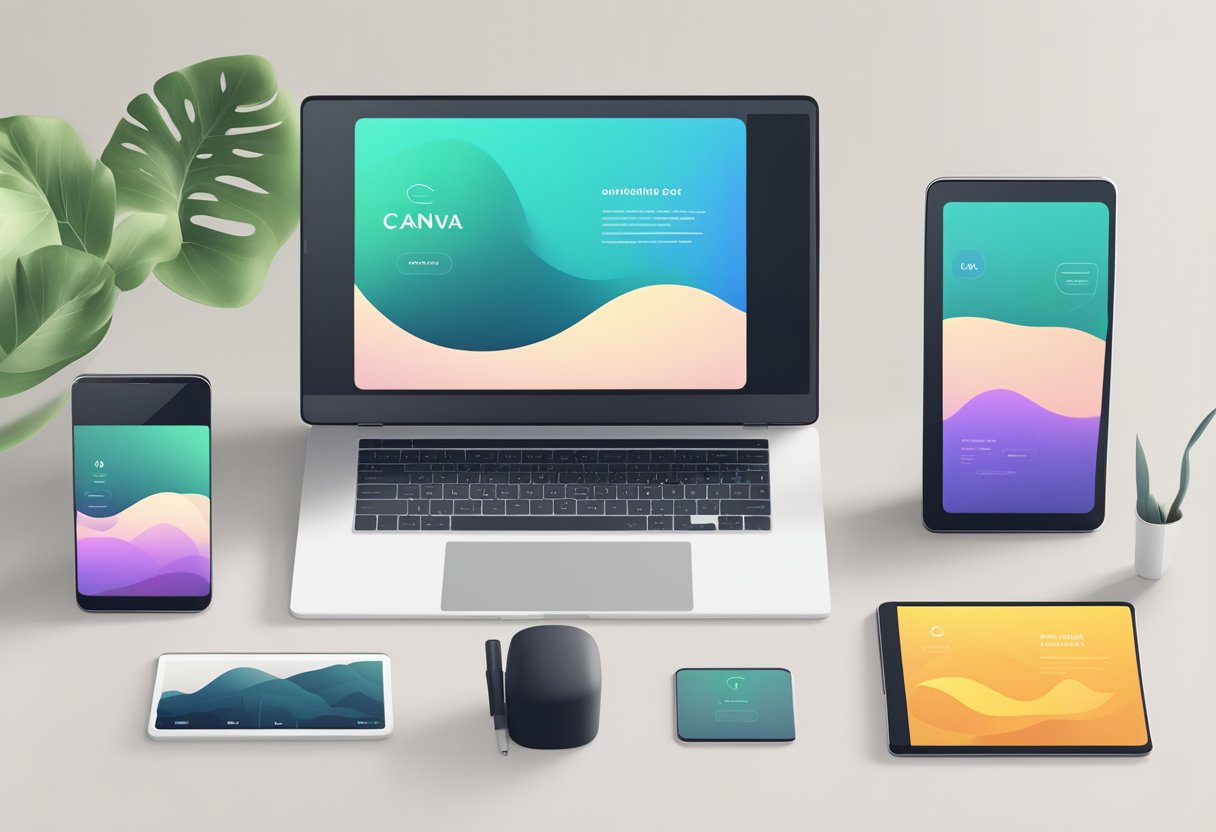How to Curve Text in Canva: Simple Steps for Eye-Catching Designs
Adding curved text to your designs can instantly elevate the visual appeal and add a creative twist to what might otherwise be a straightforward layout. Canva, a popular graphic design platform, simplifies the process of bending and shaping text within a few clicks. Whether aiming for a subtle arch or a dramatic swirl, Canva's features make it easy for hobbyists and professionals alike to achieve their desired effect without complicated design software.

Designers frequently opt for curved text to give logos, social media posts, and other graphics an artistic edge. Canva's user-friendly interface guides users through the necessary steps to not only curve the text but also adjust the shape, color, and style. The platform's versatility extends to working with a wide variety of templates and graphics, enhancing the design process further. It supports users across different devices, making it accessible for on-the-go creation, and provides a wealth of advanced text effects for those looking to dive deeper into customization.
Key Takeaways
- Curved text in Canva enhances design appeal and creativity.
- Canva offers a straightforward process for text curvature adjustments.
- The platform provides a rich feature set for design customization across devices.
Getting Started with Canva
Canva is a versatile design platform that streamlines the creation of visual content. Its intuitive interface makes it accessible for both beginners and seasoned designers. This section delves into navigating the Canva interface and utilizing its text tools to enhance your projects.
Understanding the Canva Interface
When a user first logs into Canva, they're greeted with a clean, user-friendly dashboard. Central to its design is the search bar, which allows for quick access to templates, images, and design elements. The main canvas area is where the user's design takes shape, flanked by a variety of tools and features on the sidebars. Canva ensures everything is within reach, providing users an efficient workflow.
Key Components:
- Search Bar: Easily locate specific templates or design elements.
- Side Panel: Access tools, elements, and upload options.
- Main Canvas: The visual workspace where designs are created and edited.
Accessing Text Tools
To add textual elements, users can click on the text box tool from the side panel. Here, they'll find options to insert different text styles such as headings, subheadings, and body text. Once added, they have the option to customize the text through a variety of fonts, sizes, and colors, providing flexibility and control over the design.
How to Add Text:
- Click the 'Text' icon from the side panel.
- Choose 'Add a heading', 'Add a subheading', or 'Add a little bit of body text' to insert the desired text type.
- The text box can then be moved and reshaped directly on the canvas.
The text tools in Canva enable users to tailor their messaging to fit their unique design vision, ensuring their communications are both effective and reflective of their style.
Basics of Text Curving
Mastering text curving in Canva involves a good understanding of text boxes and font choices, along with the utilisation of Canva's curve tool. This section guides the reader through the foundational elements required to effectively curve text.
Text Boxes and Fonts
Creating a text box in Canva is the first step towards curving text. Users can choose from various fonts that best suit their design, each font potentially affecting the aesthetics of the curved text outcome. It's crucial to remember that the choice of font can dramatically influence the readability and visual impact of the curved text.
Using the Curve Tool
Curving text in Canva is made straightforward with the curve tool. This tool is located within the text toolbox, and it provides a slider for adjusting the degree of the curve. Users can manipulate this slider to achieve their desired curvature, transforming plain text into curved text smoothly and efficiently. The curve tool allows for repeat adjustments until the curving of the text aligns with the users' vision.
Advanced Text Effects
In the realm of graphic design, the ability to tweak text down to the finest detail opens up a plethora of creative possibilities. Canva's suite of advanced text effects allows users to refine letter spacing, alter curve direction and angle, and apply various effects to curved text, transforming simple designs into intricate artworks.
Adjusting Letter Spacing
One has the option to manipulate the spacing between characters to achieve a specific visual rhythm or to ensure clear legibility. Adjusting letter spacing is straightforward:
- Decrease spacing: Tighten the gap between characters when texts feel too stretched out.
- Increase spacing: Add more space when characters appear too bunched together.
Learn more about adjusting letter spacing and perfecting your design.
Manipulating Curve Direction and Angle
The direction and angle of the curve in your text can influence the tone and flow of your design. It is critical to:
- Curve upward or downward: Depending on the desired impression, one can curve text to arc above or below the baseline.
- Adjust angle: Find just the right trajectory for the text's curve to maintain balance and enhance visual appeal.
Understand manipulating curve direction and angle with Canva's tools.
Applying Effects to Curved Text
Applying effects to curved text infuses it with personality and emphasis. Users should consider:
- Shadows or Lifts: Add depth to your text, making it "pop" off the canvas.
- Glow or Neon: For a more futuristic or vibrant touch, these effects can be striking.
Discover how to apply dynamic effects to your curved text.
Working with Templates and Graphics

When creating a compelling graphic design in Canva, selecting an appropriate template and coherently integrating curved text with graphics are crucial steps. These elements must work in synergy to ensure a cohesive and visually appealing design.
Choosing the Right Template
The template serves as the foundation of any design. Users should select templates that align with their project's purpose and target audience. For instance, a minimalist style may be preferable for professional presentations, while more vibrant and dynamic templates could be suitable for social media content. When looking to add curved text to your designs, consider how the template's layout and style will accommodate this feature.
Integrating Curved Text with Graphics
Curved text can add a creative touch to a design when used wisely. It's important to consider the relationship between text and graphic elements on the canvas. The text should enhance the graphic without overpowering it. One should adjust the curve degree to ensure readability and aesthetic harmony. To illustrate, a postcard might feature curved text flowing around the edge of a central image, complementing the visual focus rather than competing with it. Learning about how to curve letters on Canva can greatly affect the overall impact of the graphic design.
Canva Pro Tips
Canva Pro offers advanced features for users to enhance their design workflows. Specifically, when it comes to curving text, a Pro account unlocks valuable tools that provide a polished and brand-consistent finish.
Utilizing Canva Pro Features for Curving Text
Canva Pro users have the luxury of using the Curve Tool with enhanced flexibility. One might find the process straightforward: First, they select their text box, and then apply the curve effect via the effects menu. Additionally, Pro users can access a slider that enables precise curvature adjustments. For a harmonious design, it's crucial to match the curve radius to other circular elements in the project.
- Steps to Curve Text:
- Select the text box.
- Click on 'Effects'.
- Use the 'Curve' slider to adjust the curve degree.
The Pro account also includes a vastly expanded font library, with many fonts that may render curving effects more prominently. This feature is especially useful for distinct branding or creative presentations.
Leveraging Brand Kit and Pro Graphics
Canva Pro's Brand Kit is a game-changer for maintaining brand identity. Pro users can ensure that the curved text aligns with their brand's aesthetics by utilizing pre-set brand colors, fonts, and logos. This consistency saves time and reinforces the brand's visual identity across all designs.
- Brand Kit Utilization:
- Store brand colors and logos for easy access.
- Set specific fonts, including those used for curved text, to maintain a consistent look.
Furthermore, Canva Pro offers exclusive access to Pro Graphics, which can complement curved text. These graphics enhance visual storytelling and can be custom-fitted around text curves to create dynamic compositions.
By carefully selecting Pro graphics that align with the curvature of their text, users can design compelling visual hierarchies that guide the audience's eyes throughout the composition. The combination of curved text with bespoke graphics elevates the professional quality of the final design.
Creating Engaging Social Media Content
Crafting visually compelling content is crucial for standing out on social media platforms. Utilizing tools such as Curved Text effects in Canva can significantly enhance the visual appeal of your content by adding unique flair to headings, subheadings, logos, and badges.
Crafting Headings and Subheadings
Headings and subheadings are the anchors of social media content. They guide the reader's eye and succinctly communicate the core message. Bold and italicized text styles capture attention, while varying font sizes denote the importance of the content hierarchy. Curved text can inject a dynamic and eye-catching twist to traditional linear text layouts. For instance, to add curve to a heading or subheading in Canva, one can utilize the curved text feature which allows for creative text shaping.
Designing Logos and Badges
Logos and badges serve as visual symbols for personal or brand identity on social media. They often require a creative design that makes an instant impression. Using curves in text within a logo can set a brand apart and add an element of sophistication or playfulness. Thoughtful use of colors and graphics in conjunction with curved text can further enhance the distinctiveness of social media badges. Tips for applying these designs are available through tutorials on how to create curved text within Canva's platform.
Using Canva on Different Devices

Canva's versatility across devices ensures that users can curve text whether they're on the go or sitting at a desk. The platform's functionality adapts to the interface of mobile and desktop, providing a seamless design experience.
Curving Text on the Canva Mobile App
On mobile devices, users can access the Canva mobile app to begin their project. To curve text, one selects the text box within their workspace and adjusts using the curve function. The process involves tapping on the text element and using the slider to get the desired curvature.
Desktop vs. Mobile: A Comparison
Desktop:
- Larger workspace facilitates easier manipulation of design elements.
- Keyboard shortcuts enable quicker formatting adjustments.
Mobile:
- Touch interface simplifies direct interaction with text and objects.
- Portability allows for on-the-fly edits and project updates.
The choice between mobile and desktop platforms may depend on the user's specific project needs and their working environment. Each offers a tailored experience, ensuring the creativity is not limited by the device.
Finalizing Your Design
Finalizing a design in Canva involves ensuring all elements are well-positioned and harmoniously aligned. To truly elevate the project, meticulous attention to the placement and visual flow of curved text is essential, as is the proper process of saving and exporting the design for use.
Reviewing and Adjusting Text Placement
As they inspect their work, designers must scrutinize the position and angle of the curved text. They need to ensure that the text placement complements the overall design and is in harmony with other graphic elements. It's advisable to rotate the text, if necessary, to fit the envisioned aesthetic, and consider adjusting the color for optimal contrast and legibility.
Saving and Exporting Your Project
Once the design satisfies the aesthetic requirements, the next step involves saving the project. Canva provides various file formats suitable for multiple platforms and uses. Designers should select the format that best suits their end use, such as PNG for digital or PDF for print, and then export the file. It's important to review the exported version to confirm that the integrity of design elements such as text curvature remains intact.
By following these guidelines, one ensures that their design reflects a professional level of polish and is ready for presentation or distribution.
Troubleshooting Common Issues

When curving text in Canva, users may experience issues with text appearance and accessibility based on the plan they are using. This section will guide you through resolving these challenges.
Resolving Text and Font Anomalies
Font Issues: If text does not display correctly, it might be due to the selected font. Users should try different fonts to see which one renders properly when curved. In some cases, bold or italic variations of a font can provide better results and minimize distortion.
Grouping Elements: Should the curved text need to interact with other design elements, users must ensure all relevant items are grouped together. This can be done using the group function in Canva. Grouping helps maintain the design's structure when moving or resizing elements.
Workarounds for Limitations in the Free Version
Using the Lock Feature: The free version of Canva may limit certain functionalities. Users can employ the lock button to fix elements in place, which is helpful when arranging text around curves manually.
Duplicating Text: If a special effect on text is desired, users with the free version might have to duplicate text layers and manually adjust each layer to simulate the desired effect. Although more time-consuming, this method lifts some restrictions of the free version.
Limited Effects: Without access to all features, users can still experiment by duplicating text and applying different opacities or colors to create a unique visual effect akin to a special effect available in the premium version.
Frequently Asked Questions
Creating a curved text effect adds a dynamic flair to your designs. Here, you'll discover the specific steps for curving text in Canva, whether you can manipulate other elements in a similar way, and how these techniques translate to other applications.
What steps are involved in creating a curved text logo in Canva?
To craft a curved text logo in Canva, users start by adding text to their design and then utilizing the curved text feature. This option allows for adjusting the text's curvature with simple controls.
Can elements other than text be curved in Canva, and how?
Although primarily known for text, Canva does not currently provide a feature to curve other elements. Users looking to curve images or shapes will need to explore other software options or workaround methods.
Is it possible to generate 3D curved text in Canva, and what is the process?
Canva itself does not support true 3D text manipulation. However, users can create a pseudo-3D effect by layering multiple instances of curved text with varying shades and sizes to simulate a three-dimensional appearance.
Which app can I use to curve text, and does it integrate with Canva?
For users seeking text curving capabilities outside of Canva, Procreate offers robust tools for text manipulation including curving, and while it does not directly integrate with Canva, designs can be imported for further editing.
How can I apply curved text effects in Procreate?
In Procreate, curving text involves using the Warp Text feature to manually adjust the text to your desired shape. This can allow for more organic and unique text effects compared to Canva's automated curvature tool.
What are the methods for curving text in Microsoft Word and PowerPoint?
Microsoft Word and PowerPoint users can curve text by inserting WordArt and selecting the Transform option, which provides a variety of curved text styles. Customizable curvature is achieved through handle adjustments on the text box.